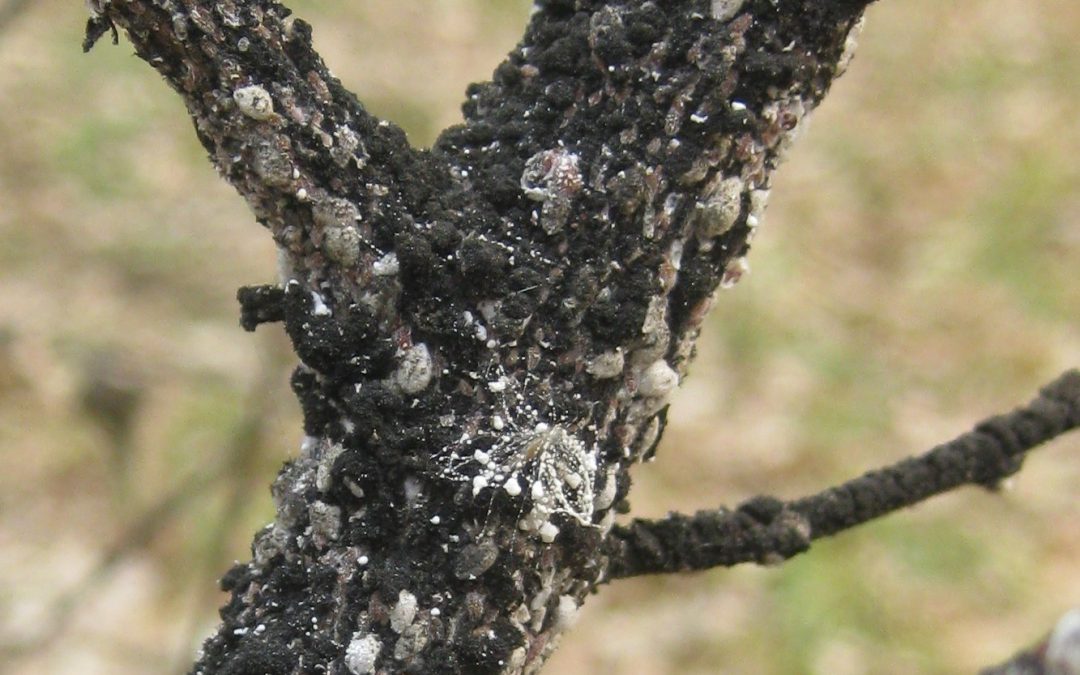
by Matthew Orwat | Feb 17, 2022
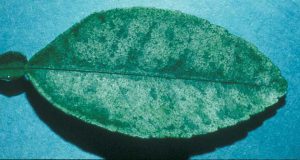
Citrus red mite leaf damage, red mites may overwinter, but are susceptible to control by dormant oil. Image UF / IFAS HS-806
During cold winter weather, one doesn’t often think about spraying fruit trees and ornamental shrubs for spring insects and diseases. It’s just not on the radar, but it turns out that January and February are the best time to apply dormant sprays to combat insect and disease issues. Many ask, “What are dormant sprays”?
Dormant sprays act on insects or disease pathogens differently. Many insects overwinter on trees and shrubs, either as eggs or immobilized in a protective shell (scale insects). Horticultural oils applied during cool dormant conditions work by smothering the eggs of some insect species or encapsulated scale insects. Since they cannot breathe, they die.
On the other hand, dormant sprays containing copper or sulfur actually kill latent fungal spores that are ready to infect the moment weather warms. They also burn tender young plant tissue, so can only be used when the plant is not actively growing. These preventative sprays can delay disease incidence in early spring and allow for reduction or elimination of regular fungicide applications. The old adage “an ounce of prevention is worth a pound of cure” surely applies to these situations.
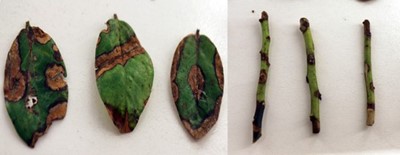
Phomopsis leaf and stem symptoms. Dormant fungicide sprays may lessen the severity of this disease.
Credit: N. Flor, UF/IFAS
There are several products on the market for dormant applications.
Dormant oil is a type of horticultural oil, made of refined petroleum products, for application on trees or shrubs when the trees are not actively growing. It has been in use for over 100 years. They are effective in the suppression of scale insects and mites. Care must be used to not apply them when daytime temperatures are above 75 degrees or night temperatures below 28 degrees. Other horticultural oils exist that may be applied during the growing season to control soft-bodied insects, but not during extremely hot weather. Many different brands exist, some are certified organic. They can be purchased at most garden centers, but the best selection is usually found at your independent nursery or farm store.
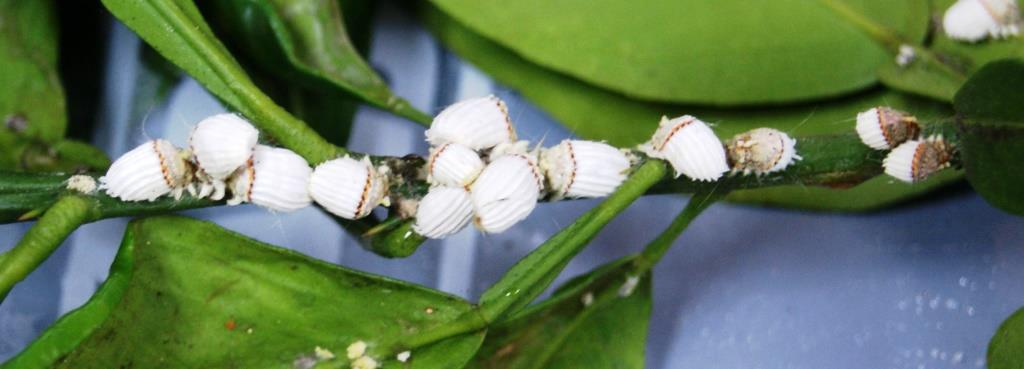
Cottony Cushion Scale, often controlled by Dormant Horticultural Oil. Image Credit, Matthew Orwat, UF / IFAS Extension
Dormant fungicides can be classified into two groups. Those that contain copper and those that contain sulfur. The most common preventative remedy for fungal disease had been lime-sulfur. It is no longer available in small home garden quantities due to shipping container restrictions, it can be purchased online in larger quantities for use in Florida. When applied to dormant plants, lime sulfur actually works by sanitizing the stem, killing all fungal spores. It cannot be used during the growing season since it burns leafy tissue. Caution must be taken when mixing and loading since, being an acidic product, can burn the skin. Wear chemical resistant gloves when applying (bought at your local hardware store for $4.00-$10.00), safety goggles and follow all label directions carefully since it is caustic and labeled DANGER. Also, never apply lime-sulfur within one month of horticultural oil applications. It should be applied in early to mid February, avoiding hard freezes for the 24 hours around application time. Sulfur based fungicide sprays may also be used instead of Lime-Sulfur as a dormant application.
Dormant copper sprays are effective on both bacterial and fungal pathogens and used primarily on fruit crops for the suppression of many fruit diseases including fire blight, bacterial leaf spot, powdery mildew, downey mildew and anthracnose. There are several different brands of copper fungicide preparations on the market, most nurseries and garden supply centers will have some in stock. Always read the label for proper personal protective equipment and dosage rates, to avoid copper buildup in the soil over time.
For more information, contact your local extension agent or consult these extension publications from: Disease Management Strategies, Florida Blueberry Disease Guide and Pest Control Using Horticultural Oils .
This article was originally published on January 2016, and has been modified to reflect current information.
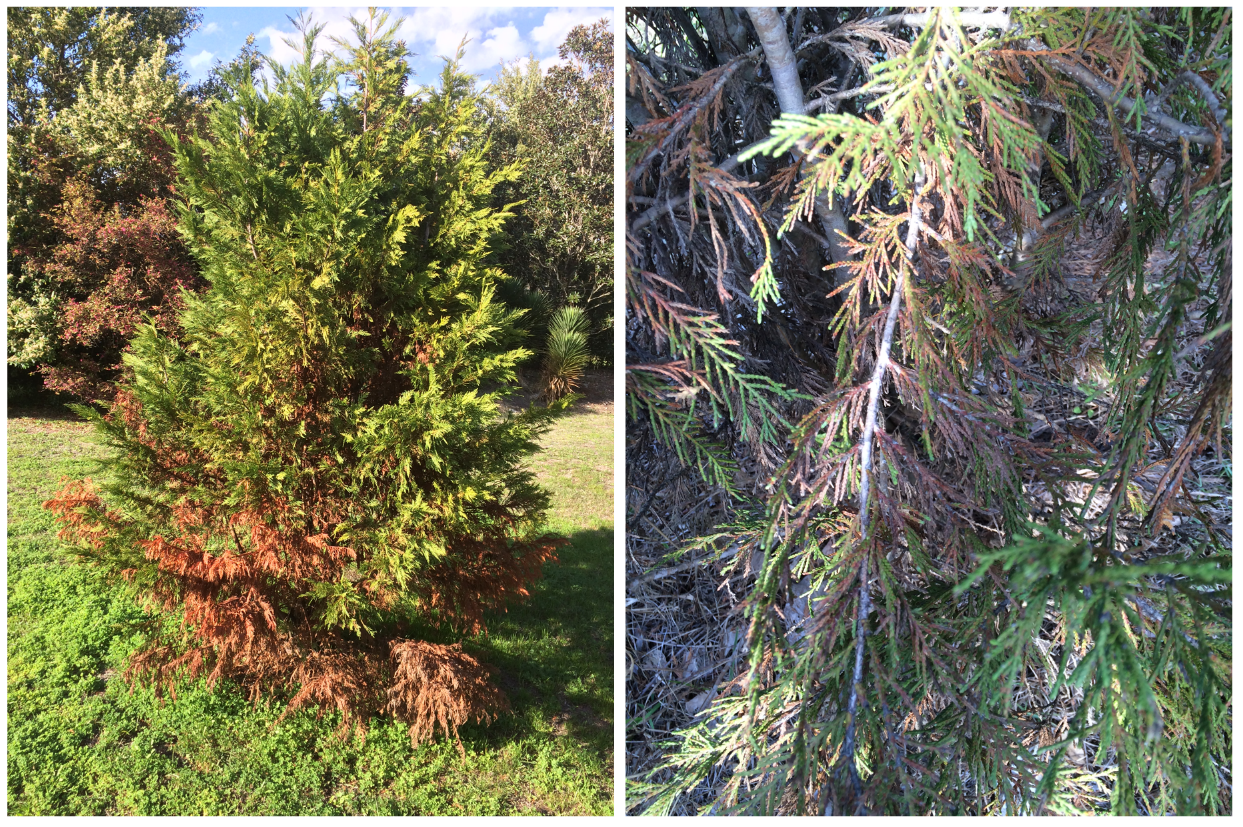
by Ray Bodrey | Apr 9, 2018
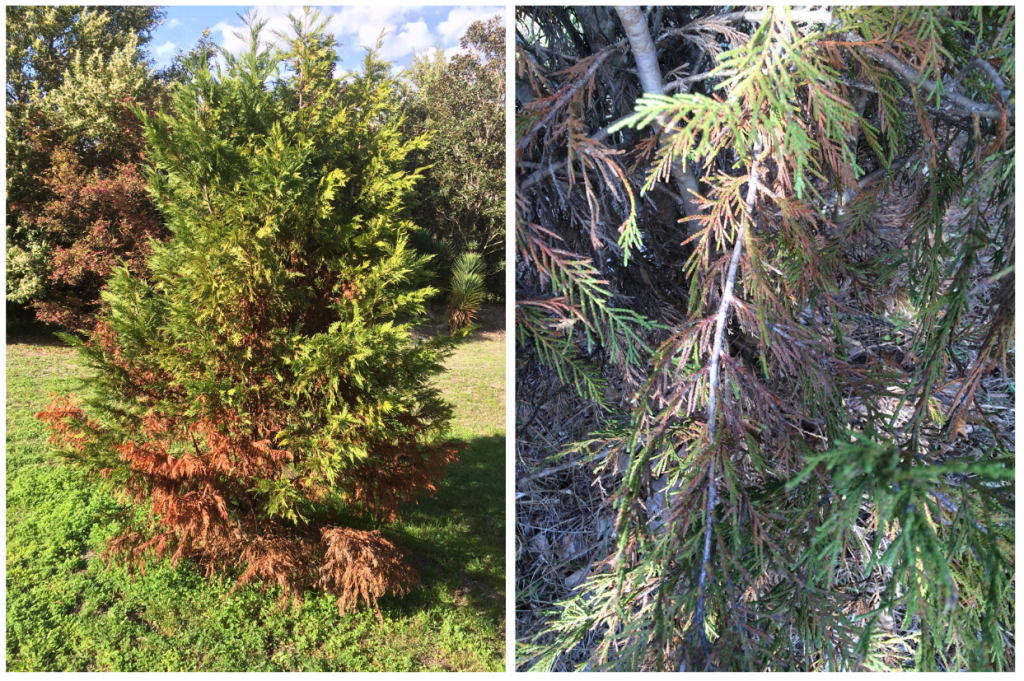
Figure: Passalora Needle Blight in Leyland Cypress. Image Credit Ray Bodrey
Leyland cypress (Cupressocyparis leylandii) has been a very popular landscape tree in the U.S. for many decades. It has endearing characteristics, most notably its fast-growing nature and ability to make an appealing boundary around property. However, various diseases have created an overwhelming survival hurdle.
Seiridium or Botryosphaeria cankers (also referred to as dieback) are fungal diseases that can strike Leyland cypress. In general terms, cankers are multiple dark oval lesions that are usually sunken into the bark. The lesions are accompanied by the flow of resin. Discolored branches will be seen first as an indicator. If the fungus finds its way into the body of the trunk, most likely the tree will not survive. With Seiridium canker, girdling of branches and stems is not an issue, however needles will fall off the branches easily. With Botryoshaeria canker, stem girdling will occur, killing the branch, but needles generally will stay on the branch.
Passalora Needle Blight or commonly known as twig blight, caused by the fungus Passalora sequoia, is a major concern in the Southeast. The disease is usually more active in the spring and summer months and affects mostly younger growth. Symptoms of the disease are the browning of needles, followed by needle drop. Disease usually begins on the lower part of the tree and moves up. Sometimes the disease is widespread on one side of the tree only, where sunlight is not able to dry moisture quickly. Ventilation is key when planting these trees as a border hedge. However, the Panhandle environment and climate is very conducive for these pathogens to affect the vulnerable Leyland cypress.
If you have or will plant Leyland cypress, there are some fungicide options to consider as preventive maintenance. It’s important to stress that trees that are already infested, will succumb to the disease regardless of treatment. Fungicides such as Daconil & Mancozeb (Pentathlon) can be used in the spring & fall. Propiconazole is the best fungicide for the warmer, summer months (June through August). Fungicides such as Myclobutanil or Thiophanate-methyl are also commonly used. Always read application directions and pay close attention to the application rate interval.
There are other evergreen options, that have a much higher likelihood of not contracting a fungal disease that can cause terminal results. Native species like the red cedar (Juniperus virginiana) or white cedar (Thuja occidentalis) are great choices. Again, these species are not totally immune to twig blight or other fungal pathogens, but they are hardier and less likely to contract diseases. For more information, please contact your local county extension office.
Supporting information for this article can be found in the following the UF/IFAS EDIS publication, “Cupressocyparis leylandii: Leyland Cypress” by Edward F. Gilman and Dennis G. Watson: http://edis.ifas.ufl.edu/pdffiles/ST/ST67100.pdf & the Clemson Cooperative Extension Publication, “Leyland Cypress Diseases & Insect Pests”: http://www.clemson.edu/extension/hgic/pests/plant_pests/trees/hgic2004.html
UF/IFAS Extension is an Equal Opportunity Institution.

by Matthew Orwat | Jan 13, 2016
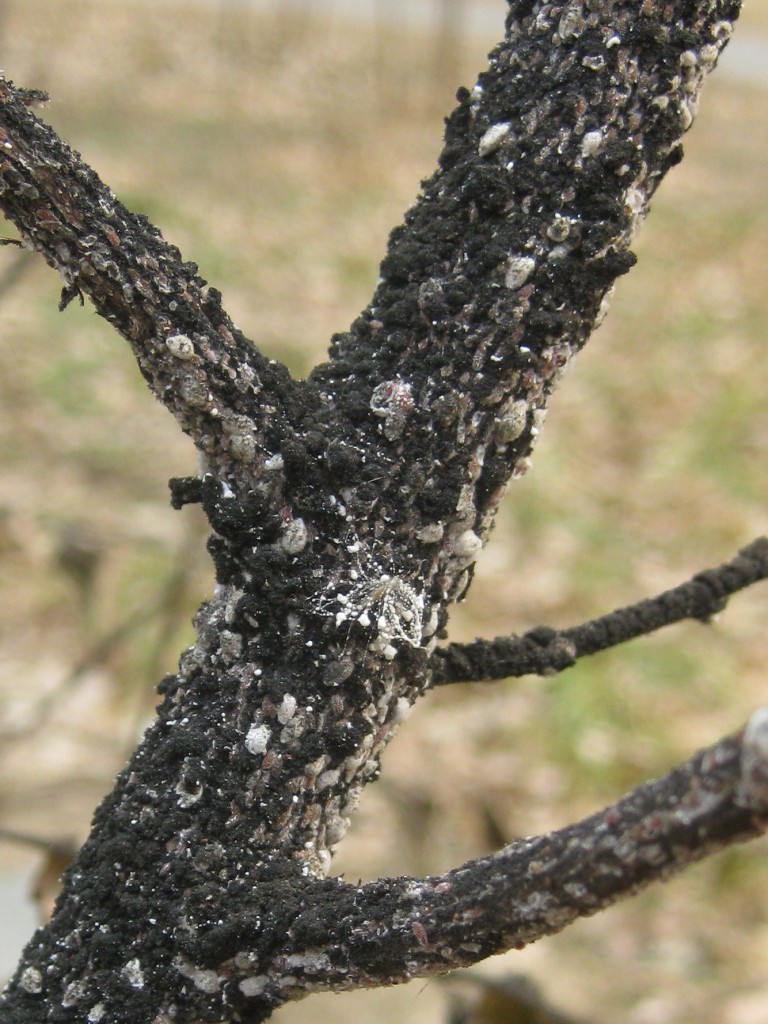
Crapemyrtle Scale, UF / IFAS Extension
During cold January weather, one doesn’t often think about spraying fruit trees and ornamental shrubs for spring insects and diseases. It’s just not on the radar. The fact is January and February are the best time to apply dormant sprays to combat insect and disease issues. Many ask, “What are dormant sprays” ?
Dormant sprays act on insects or disease pathogens differently. Many insects overwinter on trees and shrubs, either as eggs or immobilized in a protective shell (scale insects). Horticultural oils applied during cool dormant conditions work by smothering the eggs of some insect species or encapsulated scale insects. Since they cannot breathe, they die.
On the other hand, dormant sprays containing copper or sulfur actually kill latent fungal spores that are ready to infect the moment weather warms. They also burn tender young plant tissue, so can only be used when the plant is not actively growing. These preventative sprays can delay disease incidence in early spring and allow for reduction or elimination of regular fungicide applications. The old adage “an ounce of prevention is worth a pound of cure” surely applies to these situations.
There are several products on the market for dormant applications.
Dormant oil is a type of horticultural oil, made of refined petroleum products, for application on trees or shrubs when the trees are not actively growing. It has been in use for over 100 years. They are effective in the suppression of scale insects and mites. Care must be used to not apply them when daytime temperatures are above 75 degrees or night temperatures below 28 degrees. Other horticultural oils exist that can be applied during the growing season to control soft-bodied insects, but not during extremely hot weather. Many different brands exist, some are certified organic by OMRI. They can be purchased at most garden centers, but the best selection is usually found at your independent nursery or farm store.

Cottony Cushion Scale, Image Credit, Matthew Orwat, UF / IFAS Extension
Dormant fungicides can be classified into two groups. Those that contain copper and those that contain sulfur. The most common preventative remedy for fungal disease is lime-sulfur. It is applied to dormant plants and actually sanitizes the stem, killing all fungal spores. It cannot be used during the growing season since it burns leafy tissue. Caution must be taken when mixing and loading since, being an acidic product, can burn the skin. Wear chemical resistant gloves when applying (bought at your local hardware store for $4.00-$10.00), safety goggles and follow all label directions carefully. Also, never apply lime-sulfur within one month of horticultural oil applications. It should be applied in early to mid February, avoiding hard freezes for the 24 hours around application time.
Dormant copper sprays are effective on both bacterial and fungal pathogens and used primarily on fruit crops for the suppression of many fruit diseases including fire blight, bacterial leaf spot, powdery mildew, downey mildew and anthracnose. One popular option, the “Bordeaux Mixture” blends copper with lime. This lime reduces the acidic nature of the copper, thus reducing tissue damage when applied to plants. Always read the label for proper personal protective equipment and dosage rates, to avoid copper toxicity.
For more information, contact your local extension agent or consult these extension publications from: Disease Management Strategies, and Pest Control Using Horticultural Oils .







